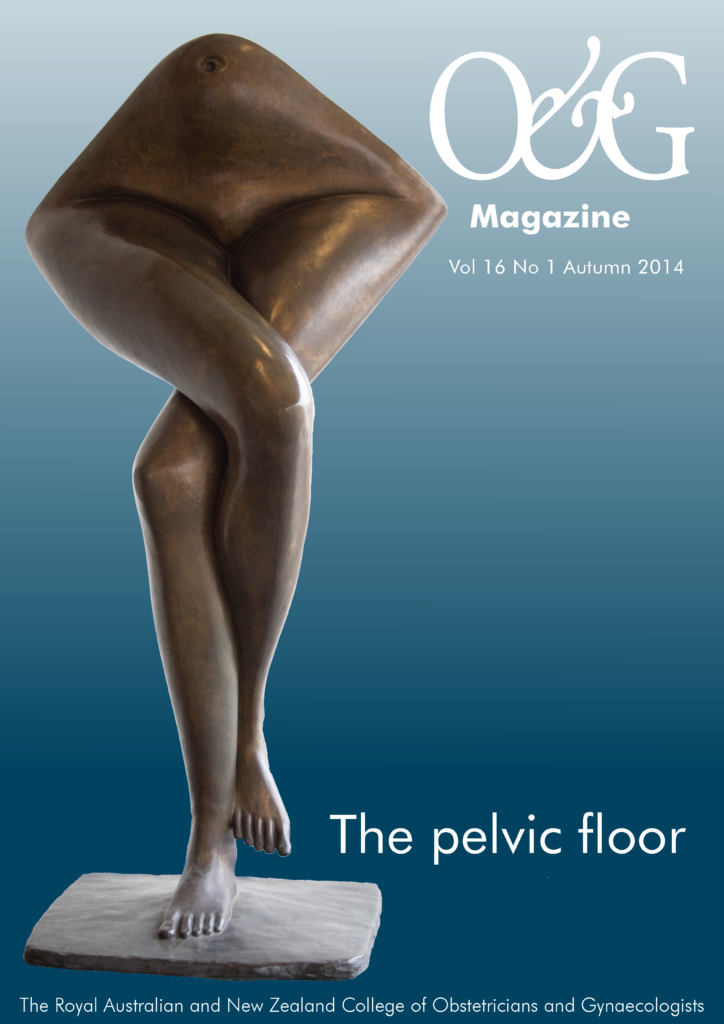Can pelvic floor dysfunction be prevented by caesarean section? Findings from the ProLong and other epidemiological studies.
Pelvic floor dysfunction (PFD) in women results in the combination of some or all of the following conditions: urinary incontinence (UI), faecal incontinence (FI) and pelvic organ prolapse (POP). It also influences sexual function.
It is a very common problem, with over 46 per cent of women having some form of major pelvic floor dysfunction and is of epidemic proportions in later life.1 Approximately 11 per cent of women undergo surgery for this condition during their lifetime, seven per cent for prolapse alone.2 In the USA, POP is thought to lead to over 200 000 surgical operations a year, resulting in an annual expenditure of US$1billion.3 Pelvic floor dysfunction surgery numbers are likely to increase substantially as the population ages.4 Therefore not only does this have significant cost implications for health services throughout the world, but it also has a significant effect on the quality of life for a large number of women. Consequently, it is of great importance to identify possible aetiological factors with a view to subsequent prevention or reduction of its impact.
regnancy and childbirth are believed to be significant predisposing factors for PFD in women. Modern imaging techniques of 3D/4D ultrasound and magnetic resonance imaging (MRI) have shown that trauma and avulsion, in particular, to the levator ani muscle, have been reported in 20–40 per cent of primipara.5 Damage to the pudendal nerve and endo pelvic fascia have also been described with vaginal birth.6
Obstetric demographics have changed over the last few years: there is now a definite trend in the developed world for women to be older when they have their first baby, babies are heavier and mothers’ BMIs are greater than in previous years. These are all risk factors for PFD. Women are also having fewer babies.7 Consequently, more women are asking the question about whether caesarean section is protective for subsequent pelvic floor dysfunction.
To answer this and to examine the relationship of other aspects of obstetric practice with subsequent pelvic floor dysfunction (UI, FI, POP and sexual dysfunction), we started our collaborative longitudinal study ProLong (PROlapse and incontinence LONG-term research study). This commenced in 1993–94 and involved the Universities of Otago, Birmingham and Aberdeen in the UK. This is the largest ongoing prospective study in this field and involves a cohort of nearly 8000 women of whom just under 50 per cent returned questionnaires at three months, six and 12 years after delivery.8,9 Women were also examined at the 12-year follow up.10 It is planned to carry out the 20-year follow up in 2014. In this article the 12-year results of the ProLong study will be presented and compared with other epidemiological studies, with particular emphasis on whether caesarean section is protective for subsequent PFD.
Urinary incontinence
At 12 years after delivery, urinary incontinence is very common, with just over 50 per cent of women having this complaint. Women who delivered exclusively by caesarean section were less likely to have UI in comparison to women who delivered vaginally, (vaginal delivery 55 per cent versus caesarean 40 per cent, OR 0.46:95 per cent CI 0.37–0.58), but not if they had a combination of caesarean and spontaneous vaginal births.10
A similar reduction is seen at 20 years after delivery in the Swedish National Survey of pelvic floor dysfunction, the SWEdish Pregnancy Obesity Pelvic floor (SWEPOP) study. This involved just over 5000 primiparous women who delivered in 1985–88 with no further births and were sent and returned a questionnaire in 2008. In that study, the prevalence of urinary incontinence after vaginal delivery was 40.3 per cent in comparison to delivering by caesarean section, which was 28.8 per cent [OR 1.67: 95 per cent CI 1.45-1.92).11
Both studies showed that there was no difference with an emergency or elective caesarean section. Other risk factors for UI are older maternal age at first birth, having four or more babies and higher BMI. Age at delivery increased the UI risk by three per cent annually, and there was an eight per cent increased risk of UI per current BMI unit in the SWEPOP study.11
Exclusive caesarean section delivery would appear to offer only partial protection for UI. However, 40 per cent of these women still report incontinence in our ProLong study, confirming a significant pregnancy effect.
Faecal incontinence
At three months after delivery, women who delivered exclusively by caesarean section were less likely to have faecal incontinence in comparison to women who delivered vaginally. However, at six and 12 years after delivery, any protection was lost.9,10,12
However, one or more forceps delivery would appear to be a significant risk factor for FI three months, six and 12 years after delivery (OR 2.08, 95 per cent CI 1.53-2.85).10
Similar findings of lack of effect of caesarean section on FI was noted in the Cochrane Review involving seven studies.12 This lack of effect was irrespective of whether the caesarean was elective or emergency.
It is surprising that caesarean section does not prevent FI, especially with the associated perineal trauma with vaginal birth. However, it is now believed that pregnancy and not just labour and delivery is an initiating factor13 and it may also affect defaecation afterwards.
Pelvic organ prolapse
Caesarean section would appear to confer more protection for POP in comparison to UI. In the ProLong study, 762 women were examined and just over 50 per cent had stage 2 prolapse.14 Exclusive caesarean section was associated with a reduced risk of objectively measured signs of prolapse 12 years after delivery (vaginal delivery 29 per cent versus caesarean five per cent, OR 0.11; 95 per cent CI 0.03-0.38)14 and symptoms of prolapse 20 years after delivery in the SWEPOP study (vaginal delivery 14.6 per cent versus caesarean 6.3 per cent, OR 2.55; 95 per cent CI 1.98-3.28).15 Both studies showed other risk factors for POP were older maternal age at first birth and higher parity; and in the SWEPOP study symptomatic POP increased three per cent with each unit increase of current BMI and by three per cent for each 100g increase of infant birth weight. Mothers under 160cm who delivered a child with a birth weight >4000g had a double prevalence of symptomatic prolapse compared with short mothers who delivered an infant weighing <4000g (24.2 v 13.4 per cent, OR 2.06: 95 per cent CI 1.19-3.55).15
In another Swedish study16, a cohort of almost 30 000 women having their first and all subsequent deliveries by caesarean section, were matched with over 60 000 women having only vaginal births and they were linked with the Inpatient Register of Incontinence and Prolapse Surgery over a mean follow up of 26 years. There was a significant increase in prolapse surgery with vaginal delivery in comparison to caesarean section (hazard ratio 9.2; 95 per cent CI 7-12.1) and a dramatically increased risk with forceps (hazard ratio 20.9; 95 per cent CI 5.5-79.9) in comparison to a caesarean delivery.16
Sexual function
In the six-year ProLong follow up of 2765 women who completed the Golombok and Rust (Reference Inventory of Sexual Satisfaction) women who suffered from UI or FI scored lower on all questions pertaining to sexual function.17 Type of delivery, however, appeared to have only little effect, except women having caesareans rated their vaginal tone better than those having other types of delivery.17 Similar findings were found in a recent study using newer validated questionnaires including the Prolapse Incontinence Sexual Questionnaire Short Form (PISQ- 12).18 At 12 months postpartum there was no difference in sexual function between women who had a vaginal delivery compared to caesarean section. Women who had an episiotomy had worse sexual function at six months; however, this had resolved by 12 months post-birth.
Overall, the literature suggests there is no significant difference in sexual function between women who had a vaginal delivery compared to women who had an elective caesarean delivery in the long term. There may be some difference in the short term, when any insult to the perineum heals, however this does not appear to be significant in the longer run.
Prevention of PFD
Prevention of PFD should be discussed with every pregnant woman as part of their routine antenatal care. This should include pelvic floor muscle training, modifiable risk factors (avoid smoking, constipation and maintain a normal BMI19) and possible elective caesarean section for women at greatly increased risk of PFD.
At present, it is difficult to identify these at-risk women and a major priority for future urogynaecological research is to identify this group of women. Unfortunately, there is no currently available antenatal biochemical or genetic test of constitutionally/genetically weak connective tissue (which is another risk factor for PFD). We are currently working on a predictive score for PFD using our databases, which we believe will be helpful to identify these at-risk women and also help to counsel women regarding prevention of PFD, including elective caesarean section.
Table 1. ProLong and other epidemiological studies – conclusions to date.
| Urinary incontinence | Faecal incontinence | Prolapse | Sexual satisfaction |
| Proportion of women who experience urinary incontinence increases from about a third soon after delivery to over half 12 years later.
Partial protection from delivery by caesarean section exclusively, but prevalence still high. No difference between elective and emergency caesareans. Protection lost with subsequent vaginal deliveries. Other risk factors for urinary incontinence:
|
The risk of long-term faecal incontinence is significantly higher after having had one or more forceps deliveries.
No increased risk by vacuum extraction. No evidence of a reduced likelihood of long-term faecal incontinence for women who had delivered exclusively by caesarean section. |
Stage 2 prolapse ‘normal’ for parous women.
Exclusive CS delivery significantly reduces risk of objectively measured prolapse 12 years after delivery and a reduced risk of symptoms by 20 years. Having a first baby at over 30 years of age increases risk of POP. Second and subsequent babies increase risk of POP. |
Minimal effect of mode of delivery on sexual satisfaction.
Incontinent women scored worse than continent women for all sexual satisfaction questions. |
Conclusion
Based on the current epidemiological evidence, caesarean section offers partial protection for pelvic organ prolapse and, to a lesser degree, UI. It appears to offer no benefit in reduction of faecal incontinence, nor has any significant effect on sexual function. A major priority in urogynaecological research is to identify at-risk women who may benefit from elective caesarean section to prevent subsequent PFD.
References
- MacLennan AH, Taylor AW, Wilson DH, Wilson D. The prevalence of pelvic floor disorders and their relationship to gender, age, parity and mode of delivery. BJOG. 2000;107:1460-70.
- Olsen AL, Smith VJ, Bergstrom JO, Colling JC, Clark AL. Epidemiology of surgically managed pelvic organ prolapse and urinary incontinence. Obstet Gynecol. 1997;89(4):501–6
- Dietz H P. The aetiology of prolapse. International Urogynaecology Journal. 2008;19:1323-9.
- Wu JM, Kawasaki, A, Hundley AF, Dieter AA,Myers ER, Sung VW. Predicting the number of women who will undergo incontinence and prolapse surgery. Am J Obstet Gynecol. 2011;205(3):230e1-5.
- Dietz HP. Pelvic floor trauma in child birth. ANZJOG. 2013;53:220- 30.
- Freeman RM. Can we prevent childbirth-related pelvic floor dysfunction? BJOG. 2013;20:137-40.
- World Population Prospects: The 2012 Revision. New York: United Nations. Department of Economic and Social Affairs, Population Division; 2013.
- MacArthur C, Glazener CM, Wilson PD, Lancashire RJ, Herbison GP, Grant AM. Persistent urinary incontinence and delivery mode history: a six-year longitudinal study. BJOG. 2006;113(2):218-24.
- Wilson P, Herbison R, Herbison G. Obstetric practice and the prevalence of urinary incontinence three months after delivery. BJOG. 1996;103:154-61.
- MacArthur C, Glazener C, Lancashire R, Herbison P, Wilson D. Exclusive caesarean delivery and subsequent urinary and faecal incontinence : a 12 year longitudinal study. BJOG. 2011;118:1000- 7.
- Gyhagen M, Bullarbo M, Nielsen T, Milsom I. The prevalence of urinary incontinence 20 years after childbirth: a national cohort study in singleton primiparae after vaginal or caesarean delivery. BJOG. 2013;120(2):144-51.
- Nelson RL, Furner SE, Westercamp M, Farquhar C. Cesarean delivery for the prevention of anal incontinence. Cochrane Database Syst Rev. 2010;17(2):CD006756.
- Milsom I, Altman D, Cartwright R, Lapitan MC, Nelson R, Sillén U, Tikkanen K. Epidemiology of Urinary Incontinence (UI) and other Lower Urinary Tract Symptoms (LUTS), Pelvic Organ Prolapse (POP) and Anal (AI) Incontinence. In: Abrams C, Kouhry and Wein, editor. Incontinence. Paris: Health Publications Ltd; 2013.
- Glazener C, Elders A, MacArthur C, Lancashire R J, Herbison P, Hagen S, Dean N, Toozs-Hobson P, Richardson K, McDonald A, McPherson G, Wilson D. Childbirth and prolapse: long-term associations with the symptoms and objective measurements of pelvic organ prolapse. BJOG. 2013;120:161-8.
- Gyhagen M, Bullarbo M, Nielsen T F, Milsom I. Prevalence and risk factors for pelvic organ prolapse 20 years after childbirth: a national cohort study in singleton primiparae after vaginal or caesarean delivery. BJOG. 2013;120(2):152-60.
- Leijonhufvud A, Lundholm C, Cnattingius S, et al. Risks of stress urinary incontinence and pelvic organ prolapse surgery in relation to mode of childbirth. Am J Obstet Gynecol. 2011;204(70):e1-6.
- Dean N, Wilson D, Herbison P, Glazener C, Aung T, Macarthur C. Sexual function, delivery mode history, pelvic floor muscle exercises and incontinence: a cross-sectional study six years post-partum. ANZJOG. 2008;48(3):302-11.
- Botros SM, Abramov Y, Miller JJ, Sand PK, Gandhi S, Nickolov A, Goldberg RP. Effect of parity on sexual function: an identical twin study. Obstet Gynecol. 2006;107(4):765-70.
- Wesnes SL, Lose G. Preventing urinary incontinence during pregnancy and postpartum: a review. Int Urogynecol J. 2013;24:889-99.







Leave a Reply